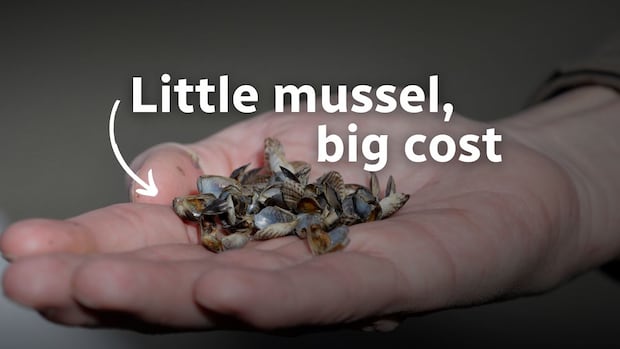Alberta fighting 'tiny invasive species' with mandatory watercraft inspections
Province becomes 1st in Canada to require checks of incoming watercraft

Highly invasive mussels are making their way through North America, and Alberta is looking to keep them out with a first-of-its-kind mandatory watercraft inspection policy.
From June 1 to Sept. 30, anyone travelling across Alberta's southern or eastern borders with any motorized or non-motorized watercraft will be required to undergo a mandatory inspection.
The goal of the inspections is to prevent zebra and quagga mussels, two highly invasive species with the potential to devastate aquatic ecosystems, from being introduced in Alberta.
"Alberta is the first province in Canada to make watercraft inspections mandatory when travelling from high-risk areas to fight these tiny invasive species," said Rebecca Schulz, provincial minister of environment and protected areas, during an announcement on Friday.
While Alberta is free of zebra and quagga mussels to the government's knowledge, increasing reports of established populations east and south of the province have prompted concern.
"With boating season now underway, we are stepping up to defend our water bodies and ecosystem to continue to protect Alberta jobs, businesses, and the water infrastructure we rely on," said Schulz.
According to provincial data, 13,408 watercraft inspections last year found 15 watercraft with invasive mussels on board.
The mandatory inspection policy comes with the opening of 11 new inspection stations, for a total of 12 stations across the province, with increased staffing, extended operating hours and on-site K-9 detection and mobile decontamination units.
Stations will be open from as early as 6 a.m. to as late as 2 a.m., with a sheriff highway patrol station near the Alberta-Saskatchewan border on Highway 1 open 24/7.
Failure to stop for a watercraft inspection could lead to a $4,200 fine, a significant increase from the $324 fine in place prior to 2024. According to the province, about 20 per cent of drivers transporting watercraft attempted to bypass watercraft inspection stations in 2024.
To fund the initiative, Budget 2025 includes the allocation of $18 million over the next five years to expand the province's aquatic invasive species inspection response programs.
Mandatory inspections start on June 1 this year, and will be conducted from May 1 to Sept. 30 starting next year.
Highly invasive, destructive species
Zebra and quagga mussels are tiny animals — both typically measure under five centimetres in length — but can have catastrophic impacts on the ecosystems they invade.
As prolific filter feeders, these mollusks consume food particles in the water, leading to significant disruptions in the food chain and potentially even a decrease in fish populations as their presence depletes resources for native fish and shellfish species.
Female zebra mussels can produce up to one million eggs per year. Mussel larvae rapidly spread by following currents and attaching to any solid surface they encounter, including boats, plants and other shellfish species such as native mollusks.
With the right climate conditions, zebra and quagga mussels can survive out of water for an extended period of time — 30 days according to the Government of Alberta — making watercraft inspections, in addition to proper cleaning, draining and drying of watercraft and equipment, of the utmost importance.
"These measures are essential to avoid long-term, costly ecological and economic impacts and to protect our waters and aquatic ecosystems before irreversible damage occurs," said Megan Evans, executive director of the Alberta Invasive Species Council.

Zebra and quagga mussels are not established in Alberta at this time. Zebra mussels have been detected in Ontario, Quebec, New Brunswick and as far west as Manitoba. It's believed that watercraft transport has been the primary method of movement for invasive mussels across Canada and the United States.
The province estimates an infestation of invasive mussels would cost $75 million a year — water infrastructure such as drinking water, power generation and irrigation systems would need to be both protected and replaced, while there would be a substantial decrease in revenue from recreational fishing combined with a decrease in property values and increases in boat maintenance costs.
"Preventing the introduction of invasive species like zebra and quagga mussels requires proactive action," said Evans.

Zebra and quagga mussels both hail from Eastern Europe, with the two species first being detected in the Great Lakes in 1986 and 1989, respectively. Much smaller than native mussel species, these invasive shellfish have brown shells that may have banding patterns. Zebra mussel shells are triangular in shape, while quagga mussels sport D-shaped shells.
If a suspicious-looking mussel is spotted, the most telling sign that the mussel is an invasive species is whether it is found attached to anything. Native mussel species typically bury themselves in the sand, while zebra and quagga mussels are most often found attached to solid surfaces.
Sightings of invasive species can be reported by calling Alberta's Invasive Species Hotline at 1-855-336-2628.


